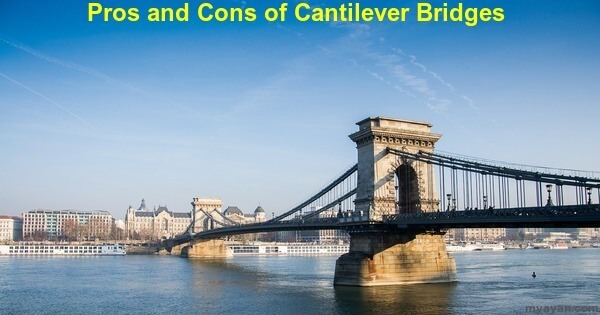The Hassfurt Bridge in Germany is one of the greatest and oldest examples of cantilever bridges. These structures are among the most common types in the world, used in various civil engineering. Even today, this type of bridge is distinctive due to its design, which uses beams and piers that jut out into the open space, providing a vital connection for pedestrians, vehicles, and even trains. However, as with most engineering solutions, cantilever bridges also have their own set of advantages and disadvantages that we need to consider. This article will look at the pros and cons of cantilever bridges, providing you with everything you need to know about these bridge structures.
There are many pros of cantilever bridges from the standpoint of civil engineering. These include:
The construction of a cantilever bridge is similar to the construction of a regular bridge, but with some additional components that help to give the bridge its strength and flexibility. The abutment is typically made from reinforced concrete or steel, while the other parts of the bridge are usually made from wood or metal beams.
These pieces are then connected to form the full structure. The bridge is typically supported by a series of tension rods, which are used to hold the abutment in place and keep the bridge from moving or collapsing.
Cantilever bridges use cantilevers, which are rigid arms that extend from the bridge’s main support structure, to apply load without having to bear it directly.
This helps distribute the weight of vehicles and other loads evenly across the entire structure, making it more resistant to wear and tear over time. The steel and concrete used to construct cantilever bridges are also highly durable materials, providing added strength and protection against the elements.
These structures require less material than traditional bridge designs, making them cost-effective solutions. Their construction also takes less time, as all components can be assembled onsite without the need for extensive welding or other fabrication processes.
Plus, cantilever bridges provide greater flexibility in terms of accommodating heavier loads since they are built with a series of beams that support one another. This reduces the risk of failure due to stress or natural disasters such as floods, earthquakes, and high winds.
Cantilever bridges can be used to create dynamic and visually appealing designs, giving them a distinct appearance from other bridge styles. The structural components are typically hidden within the structure, offering an uninterrupted view of the span. This makes cantilever bridges great for scenic areas or locations where aesthetics are important.
Cantilever bridges are an excellent choice for locations where access is limited or when heavy loads need to be carried across spans. Cantilevers are especially suited for transporting multiple lanes of traffic onto and off of a bridge deck.
This adaptability makes them useful in cases such as highway expansions or retrofitting existing structures with new decks. The flexibility also helps them to accommodate large volumes of traffic, as well as changes in the environment, such as water levels or seismic conditions.
Despite their many advantages, there are also some potential drawbacks to cantilever bridges, such as:
The design of a cantilever bridge can be complex and challenging to construct, meaning that the building process can be time-consuming and labor-intensive. This can raise the cost and delay the project completion date.
Although cantilever bridges require less maintenance than other bridge types, they still require periodic upkeep. Cleaning, inspections, and repairs can be expensive and time-consuming, especially if they need partial bridge closures or detours.
Cantilever bridges can be vulnerable to fatigue due to the constant movement of dynamic loads, especially heavy vehicles. In addition, extreme weather or natural disasters can cause severe damage to the bridge, resulting in repair or even replacement.
Cantilever bridges are not well suited to pedestrian and cyclist traffic due to their structure, which often does not allow dedicated lanes for pedestrians. This can create challenges for those who need to cross the bridge on foot or bike.
Cantilever bridges can be expensive to build and maintain due to their complexity and labor-intensive construction process. This may make them prohibitively expensive for smaller projects or those with limited budgets.
In conclusion, cantilever bridges can be a highly effective and efficient solution for transportation infrastructure challenges. They offer structural and aesthetic advantages that make them an attractive choice for engineers and city planners. However, they also have their drawbacks, such as maintenance challenges and limited access for pedestrians and cyclists. By considering the pros and cons of cantilever bridges, we can make informed decisions about their use and ensure that they are being used in the most appropriate contexts. So, the next time you cross a cantilever bridge, take a moment to appreciate its incredible design and engineering while also keeping its advantages and disadvantages in mind.

Cantilever bridges have the advantage of not requiring falsework, which is a temporary support structure used during construction. This makes them particularly well-suited for areas prone to flooding, such as deep gorges and rivers, where the use of falsework could pose safety risks.
The steel truss cantilever bridge marked a significant engineering milestone upon its introduction. It possesses the remarkable ability to span distances exceeding 460m, while also offering the advantage of simplified construction, particularly at challenging crossings where minimal or no temporary supports are required.
Cantilever bridges are often a more cost-effective option compared to other types of bridges due to their simplified construction and fewer components required.
Bridges offer several advantages over dentures. Not only are they more visually appealing, but they also have a lifespan of around 10 years. Additionally, they only require two dental visits: one for preparation and another for fitting.